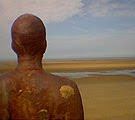
Spurred on by yesterday's visit to Cornerhouse, Manchester City Centre to watch final short film presentations from postgraduate students, I have decided to start my first short "Visual Narrative" film titled "Tide waits for no man".
This film is going to be based on Antony Gormley's Another Place. Situated on Crosby Beach, this artwork features 100 life-size, naked figures spread out along 1.8miles (3km) of the Merseyside shoreline. I am going to film this installation in black and white on one of the super 8 Cine Cameras over the next few days (Weather dependant) as I really want the lighting to work its magic on the sculptures.
As for the narrative I have undertaken some research into "Time & Tide" and below is a short explanation:
Meaning
No one is so powerful that they can stop the march of time.
Origin
The origin is uncertain, although it's clear that the phrase is ancient and that it predates modern English. The earliest known record is from St. Marher, 1225:
"And te tide and te time þat tu iboren were, schal beon iblescet."
A version in modern English - "the tide abides for, tarrieth for no man, stays no man, tide nor time tarrieth no man" evolved into the present day version.
The notion of 'tide' being beyond man's control brings up images of the King Canute story. He demonstrated to his courtiers the limits of a king's power by failing to make the sea obey his command. That literal interpretation of 'tide' in 'time and tide' is what is now usually understood, but wasn't what was meant in the original version of the expression. 'Tide' didn't refer to the contemporary meaning of the word, i.e. the rising and falling of the sea, but to a period of time. When this phrase was coined tide meant a season, or a time, or a while. The word is still with us in that sense in 'good tidings', which refers to a good event or occasion and whitsuntide, noontide etc.
I am really looking forward to starting work on this first short film and will post more information on this post as it progresses.
Whilst continuing to research this topic I have just stumbled across the work of the Lecturer for our MA course, Lawrence Giles!!!!
http://13thfloor.co.uk/mainframeset.htm
PROJECT RATIONALE
The seaside piers around the coast of Britain not only stand as a powerful reminder of the achievements of Victorian engineers and entrepreneure, but more importantly act as a catalyst for the creation and sharing of early and formative memory.
The revisiting of known/familiar sites are rich in connotations associated to the ebb and flow of our own remembering and hint at times towards the fragments of memory captured and collected from our past and now revisited/washed ashore. Our first encounter of these sites are predominately rooted in our formative years by either our parents or grandparents and frequently culminate in ourselves revisiting or introducing our own lineage to these locales.
Time and Tide explores the place seaside pleasure piers hold in ourchildhood and collective memories. As a comprehensive survey, Time and Tide highlights the cultural importance of these sites, as individual artworks, the photographs defy time - on occasions figures reappear in a different part of the image, the passing of time, a stroll along the beach or a football game are part of the experience.
The recording, documentation, filing and preserving of a photographic record is, by its very nature, an act of faith in the future. As an aide memoire, and as we ourselves visit/revisit these areas we are in essence involved the continual process of 'remembering the past by the creation of the new'.
Perhaps central to this revisiting lies in our own sense of the familiar and in the security that implies and instils. This 'comfort in the familiar' is implicit and constant and it is perhaps this commonality that links these sites to each other and ourselves in turn to them.
As Lawrence George Giles states "The beauty of these sites of leisure therefore exist in their similarity, in the aspect of the constant, the known and the given. It is this significance in these apparent and seemingly insignificant moments of time that I am attempting to capture and collect to the work itself - not in the sense of the personal and private record or document, but more so in the creation of an album of communally shared private moments."

No comments:
Post a Comment